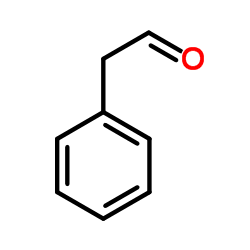Phenylacetaldehyde

Phenylacetaldehyde structure
|
Common Name | Phenylacetaldehyde | ||
|---|---|---|---|---|
| CAS Number | 122-78-1 | Molecular Weight | 120.148 | |
| Density | 1.0±0.1 g/cm3 | Boiling Point | 198.0±9.0 °C at 760 mmHg | |
| Molecular Formula | C8H8O | Melting Point | −10 °C(lit.) | |
| MSDS | Chinese USA | Flash Point | 89.2±10.2 °C | |
| Symbol |

GHS07 |
Signal Word | Warning | |
|
Identification of olfactory receptor neurons in Uraba lugens (Lepidoptera: Nolidae) and its implications for host range.
J. Insect Physiol. 78 , 33-46, (2015) Phytophagous insects detect volatile compounds produced by host and non-host plants, using species-specific sets of olfactory receptor neurons (ORNs). To investigate the relationship between the range of host plants and the profile of ORNs, single sensillum r... |
|
|
Volatile Compounds from Grape Skin, Juice and Wine from Five Interspecific Hybrid Grape Cultivars Grown in Québec (Canada) for Wine Production.
Molecules 20 , 10980-1016, (2015) Developed from crosses between Vitis vinifera and North American Vitis species, interspecific hybrid grape varieties are becoming economically significant in northern areas, where they are now extensively grown for wine production. However, the varietal diffe... |
|
|
Mosquito odorant receptor for DEET and methyl jasmonate.
Proc. Natl. Acad. Sci. U. S. A. 111(46) , 16592-7, (2014) Insect repellents are important prophylactic tools for travelers and populations living in endemic areas of malaria, dengue, encephalitis, and other vector-borne diseases. DEET (N,N-diethyl-3-methylbenzamide) is a 6-decade-old synthetic repellent, which is st... |
|
|
Comparison of Aroma-Active Volatiles in Oolong Tea Infusions Using GC-Olfactometry, GC-FPD, and GC-MS.
J. Agric. Food Chem. 63 , 7499-510, (2015) The aroma profile of oolong tea infusions (Dongdingwulong, DDWL; Tieguanyin, TGY; Dahongpao, DHP) were investigated in this study. Gas chromatography-olfactometry (GC-O) with the method of aroma intensity (AI) was employed to investigate the aroma-active comp... |
|
|
Approaches of aroma extraction dilution analysis (AEDA) for headspace solid phase microextraction and gas chromatography-olfactometry (HS-SPME-GC-O): Altering sample amount, diluting the sample or adjusting split ratio?
Food Chem. 187 , 44-52, (2015) Aroma extract dilution analysis (AEDA) is widely used for the screening of aroma-active compounds in gas chromatography-olfactometry (GC-O). In this study, three aroma dilution methods, (I) using different test sample volumes, (II) diluting samples, and (III)... |
|
|
Characterization of Volatile Flavor Compounds in Chinese Rice Wine Fermented from Enzymatic Extruded Rice.
J. Food Sci. 80 , C1476-89, (2015) Enzymatic extrusion, instead of traditional steam cooking, to treat rice is an efficient and alternative pretreatment for Chinese rice wine fermentation. In order to determine the formation of volatiles in enzymatic extrusion-processed rice wine (EE), and to ... |
|
|
A two-stage combined trickle bed reactor/biofilter for treatment of styrene/acetone vapor mixtures.
J. Environ. Sci. Health. A. Tox. Hazard. Subst. Environ. Eng. 50 , 1148-59, (2015) Performance of a two-stage biofiltration system was investigated for removal of styrene-acetone mixtures. High steady-state acetone loadings (above C(in)(Ac) = 0.5 g.m(-3) corresponding to the loadings > 34.5 g.m(-3).h(-1)) resulted in a significant inhibitio... |
|
|
Aroma improvement by repeated freeze-thaw treatment during Tuber melanosporum fermentation.
Sci. Rep. 5 , 17120, (2015) The aroma attributes of sulfurous, mushroom and earthy are the most important characteristics of the aroma of Tuber melanosporum. However, these three aroma attributes are absent in the T. melanosporum fermentation system. To improve the quality of the aroma,... |
|
|
Ammonia and formaldehyde participate in the formation of 2-amino-1-methyl-6-phenylimidazo[4,5-b]pyridine (PhIP) in addition to creati(ni)ne and phenylacetaldehyde.
Food Chem. 155 , 74-80, (2014) The formation of formaldehyde from phenylacetaldehyde and phenylalanine, and the contribution of both formaldehyde and ammonia to the production of PhIP from phenylacetaldehyde and creatinine were studied in an attempt to clarify the reaction pathways that pr... |
|
|
Effect of nine plant volatiles in the field on the sex pheromones of Leguminivora glycinivorella.
Nat. Prod. Commun. 8(3) , 393-6, (2013) Attraction of the soybean pod borer, Leguminivora glycinivorella (Matsumura), an economically important pest of soybean, to nine plant volatiles, alone or combined with two kinds of synthetic sex pheromone, ((E,E)-8,10-dodecadienyl acetate (EE8,10-12:Ac), or ... |